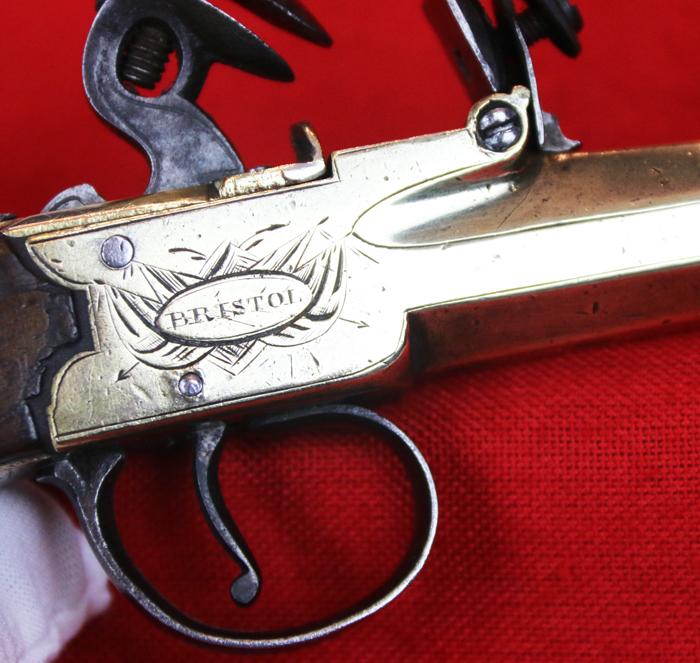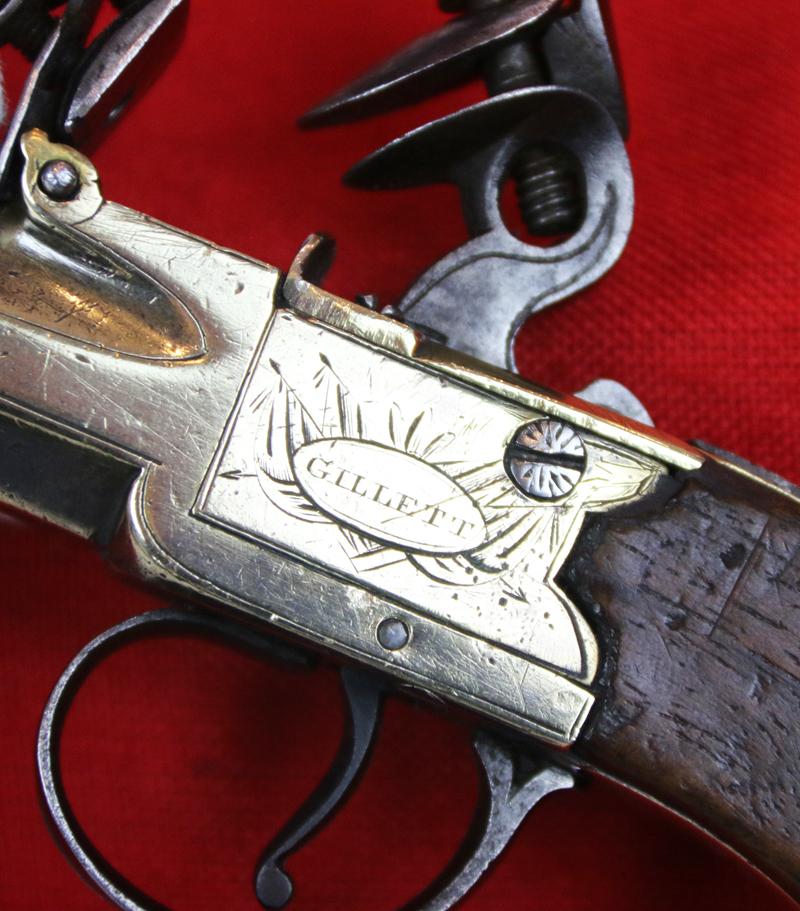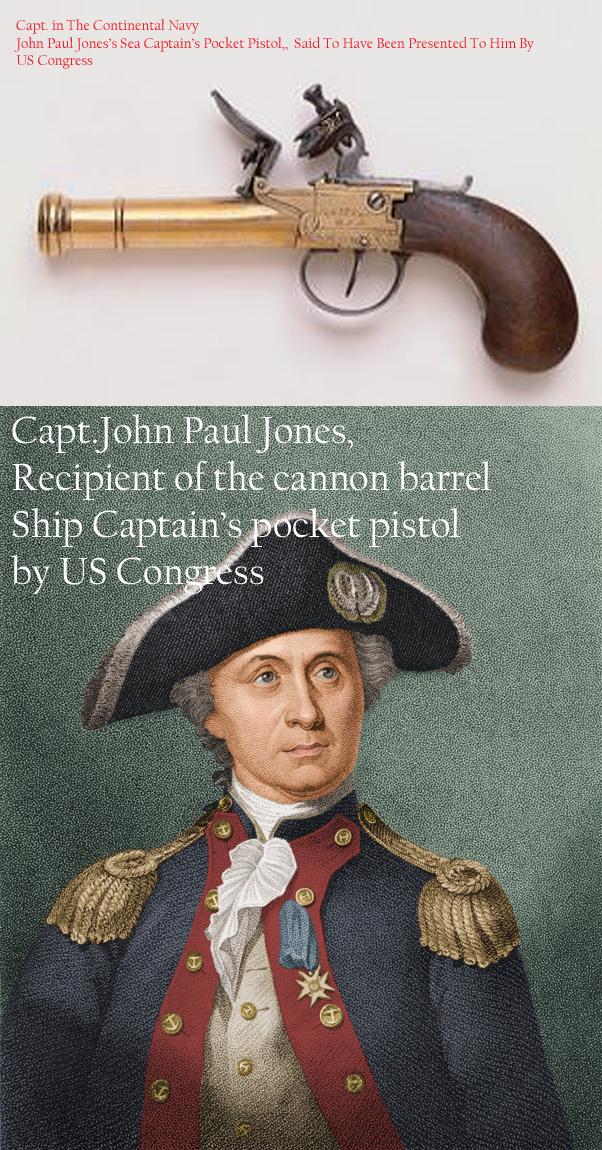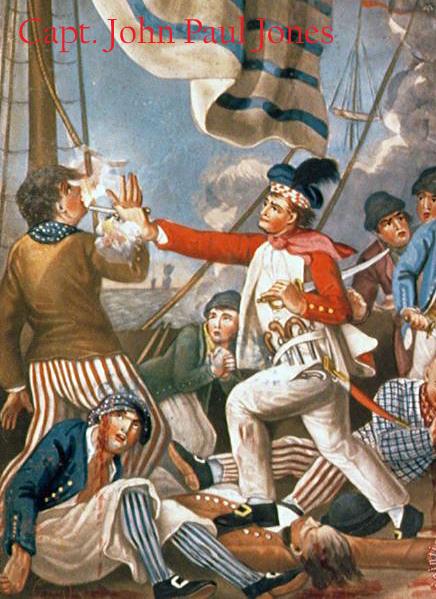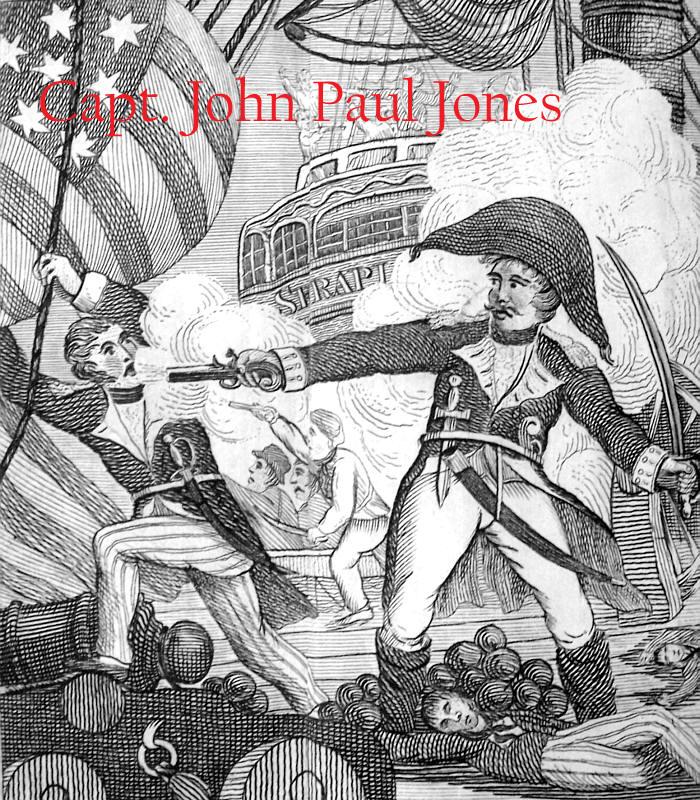A Fabulous, 18th Century Sea Captain's Brass Cannon Barrel Pocket Blunderbuss Pistol. A Near Pair to the Pistol Presented To America’s Most Famous Revolutionary War Naval Commander John Paul Jones
This has to quite simply be one of the most beautiful and outstandingly attractive 18th century pocket pistol you will ever see.
A rare and and most fine original 18th Century Sea Captain's cannon barrel pocket Pistol, that is almost a pair to the John Paul Jones Sea Captain’s pistol presented to him by the 18th century American Congress
Brass cannon barrel flintlock pocket pistol, the barrel is three stage cannon barrel type, with a good working flintlock action, with sliding safety catch, maker marked by a fine maker, from a world renown English naval port and harbour, Bristol.
We show in the gallery a photograph of an almost identical brass cannon barrelled ships captain's pocket pistol in the Massachusetts Historical Society Museum Collection, a near pair to our pistol, that was said to have been presented by US Congress to John Paul Jones (1747-1792), a newly appointed captain in the Continental Navy, on October 10, 1776.
In many respects such a pistol was considered a symbol of rank and status in both the British and American navies, as it is said only the Captain would be permitted to carry such an arm on board, hence its presentation by Congress to Jones as a symbol of his command of a ship of the line in the US Navy.
As early as 1420, vessels from the English port Bristol were regularly travelling to Iceland and it is speculated that sailors from Bristol had made landfall in the Americas before Christopher Columbus or John Cabot. After Cabot arrived in Bristol, he proposed a scheme to the king, Henry VII, in which he proposed to reach Asia by sailing west across the north Atlantic. He estimated that this would be shorter and quicker than Columbus' southerly route. The merchants of Bristol, operating under the name of the Society of Merchant Venturers, agreed to support his scheme. They had sponsored probes into the north Atlantic from the early 1480s, looking for possible trading opportunities. In 1552 Edward VI granted a Royal Charter to the Merchant Venturers to manage the port.
By 1670, the city had 6,000 tons of shipping, of which half was used for importing tobacco. By the late 17th century and early 18th century, this shipping was also playing a significant role in British world trade.
John Paul was born near Kirkbean in Scotland to John Paul, Sr. and Jean McDuff. He first went to sea as an apprentice at the age of 13 and continued to work on merchant and slave ships as a young man. On a voyage aboard the brig John in 1768, both the captain and a ranking mate of his vessel died suddenly of yellow fever, and John Paul navigated the ship safely back to port. As a reward, the Scottish owners promoted him to master of the ship and its crew. Eventually he fled Scotland for North America to avoid charges of murder, due to his killing of a so-called mutineer in Tobago, and changed his name to John Paul Jones. He was assigned as a 1st Lieutenant in the newly-founded Continental Navy on 7 December 1775 and went on to become the first well-known naval commander in the Revolutionary War. He is sometimes referred to as the "Father of the American Navy". After a long career, including a stint in the Imperial Russian Navy, he died in Paris in 1792. During the American Revolution Capt John Paul Jones urged that “open and hostile operations” be utilised on any of “the Towns of Great Britain or the West Indies.” These targets, included the important ports of “London, Bristol, Liverpool, Glasgow and Edinburgh,” He suggested a brilliant US naval war strategy, in that he acknowledged that the US Continental Navy couldn't possibly defend the American ports and harbours against attack by the most superior Royal Navy. However, if the US Navy attacked the poorly defended enemy harbours and towns the Royal Navy would be forced to divert ships to defend all vulnerable British ports and thus keep those vessels away from the American harbours and coastal towns. In the gallery we show period paintings and engravings of Capt.Jones utilising his small box lock pistols in his numerous naval close combat assaults.
One interesting reveal as to Capt Jones character.
Before he fled England to avoid a murder charge he lived for some time in the sea port town of Whitehaven, where, apparently, the locals treated him well, and with the usual friendliness and courtesy as to expected. However some few years later, at 11 p.m. on April 22, 1778, Commander John Paul Jones led a small detachment of two boats from his ship, the USS Ranger, to raid the shallow port at Whitehaven, England, where, by his own account, 400 British merchant ships are anchored. Jones was hoping to reach the port at midnight, when ebb tide would leave the shops, that he intended to plunder, at their most vulnerable.
Jones and his 30 volunteers had greater difficulty than anticipated rowing to the port, which was protected by two forts. They did not arrive until dawn. Jones’ boat successfully took the southern fort, disabling its cannon, but the other boat returned without attempting an attack on the northern fort, after the sailors claimed to have been frightened away by a ‘noise’. To compensate, Jones set fire to the southern fort, which subsequently engulfed the town, and burnt much to the ground, rendering many of the townsfolk homeless and thus destitute. Some might say it is a most interesting way of repaying his historical debt of courtesy to the decent people of Whitehaven. However, it must be pointed out that legend has it that Capt. Jones was of a most chivalric character, and had many fine points, none the least of which was his much respected skill in his new tactics of attacking his former home in order to cause terror and fear to the people of England.
Benjamin Franklin fully agreed with Captain Jones new tactic of terror and fear warfare, but he considered he could not condone it officially, as he believed it would be most counter productive to appear that a new sovereign nation could be engaging in what we we would call today, terrorism. Political sensitivities were as much a part of life then as they are today, and were indeed over, say, two thousand years ago, or in fact, likely since the dawn of mankind, and whenever it was that for the very first time a stone age man began to consider what others would think of him or her, and how he or she was regarded by their neighbours.
Every single item from The Lanes Armoury is accompanied by our unique Certificate of Authenticity. Part of our continued dedication to maintain the standards forged by us over the past 100 years of our family’s trading, as Britain’s oldest established, and favourite, armoury and gallery
Code: 22281
2395.00 GBP



